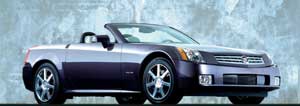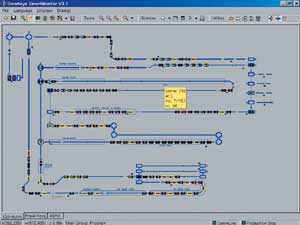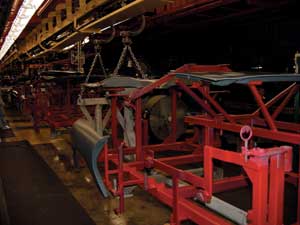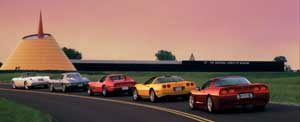The parking lot in front of the GM Bowling Green plant’s main entrance in western Kentucky, which produces one of America’s greatest automobiles—the Corvette—is restricted: Corvettes only. That’s the first indication of how seriously folks in the Bluegrass State (famous for another mode of fast transportation—the Thoroughbred) take manufacturing the Corvette, which turns 50 this summer, and how seriously owners take owning them. Inside the paint shop, a unique method of painting and the latest in technology, reinforce the point.
“This is the only vehicle where all of the exterior panels are painted before installation on the car,” says John Durney, Bowling Green’s launch manager for paint. “The Corvette’s special construction lets us take several steps to deliver a higher-quality paint job that simply isn’t possible on conventional metal-bodied automobiles.”
Painting the panels separately has a big payoff for the award-winning (see sidebar) plant. If the paint finish on a
door or a fender needed to be repaired under the previous system, the entire body had to be sent to the automatic
storage and retrieval system (ASRS). The body would then be retrieved and sent to the repair line where the
defective panels would be sanded, the good panels masked and the whole vehicle repainted. This was labor
intensive and tended to introduce additional quality problems during the process. It could also introduce schedule
delays at the trim department if the repair process took too long.

Better cost and quality control
The current swap process includes an inventory of painted panels on the swap deck for each active panel/color combination. This allows paint shop personnel to swap a defective panel with a good one from inventory so that the vehicle panel set can be delivered to trim on time. The process avoids delays and saves a substantial amount of paint, curing, labor and movement through the plant.“The main benefits of the swap process are cost and quality control,” notes Gary Newhall, engineering manager with Smarteye Corp. (Rochester Hills, MI). The company’s routing and tracking system was installed in 1995 and controls all product flow through the paint shop and the ASRS. “If a hood gets swapped out, for example, it’s sanded, repainted and returned to swap inventory. If it’s repainted again and there’s a film-build or other quality problem, you lose just that part, not a whole body.”
Like other modern automotive paint and manufacturing plants, GM Bowling Green is substantially automated, with robots and computers doing much of the heavy lifting and much of the not-so-heavy lifting. And the plant continues to update its processes with the latest in labor-saving and performance-enhancing technologies.
In fact, the Bowling Green plant has implemented a number of major changes over the past two decades. Corvettes used to be coated with a lacquer paint that required polishing to bring out the gloss. When assembly operations moved from St. Louis to Bowling Green in 1981, the plant switched to a basecoat and clearcoat enamel finish.
The Corvette was one of the first GM products to adopt the more modern finish. Enamel’s advantage over lacquer is its vastly superior durability. And because the enamel cures chemically, compared to lacquer’s evaporative curing, no rubbing or polishing is necessary for a brilliant shine.
One of the next major finishing changes came with the introduction of the fifth-generation Corvette in 1997. New waterborne basecoats replaced the solventborne material used previously, a move that brought two more benefits. “Waterborne paint yields richer and deeper-looking colors,” Durney says. “It also helps significantly reduce the VOCs vented to the atmosphere. The previous formula had about 60% solvent; it’s about 10% now.”
The new Cadillac XLR Roadster that was recently added to production at Bowling Green will share these same
paint processing and assembly innovations.

Body panels’ path
Composite body panels arrive at Bowling Green ready for priming and painting. After inspection, they’re loaded on panel racks on the main conveyor line. Each rack supports a complete panel set for a Corvette, minus bumper covers, in what looks like an exploded orientation.“Panels are suspended for painting exactly the way they’ll end up on the vehicle, except that we provide the clearance needed for the robot to spray corners and edges to achieve full coverage,” Durney says. “Fascias require a different type of support, so they’re painted on a separate line.”
From start to finish, panels spend 10 hours winding two miles on a serpentine path through the 250,000-square-foot facility that occupies 25% of GM Bowling Green’s entire floor space.
Cleanliness standards require workers to wear special coveralls and hairnets. Access to the paint shop is limited, and employees pass through a series of air showers that help keep the shop squeaky clean. Air within Bowling Green’s cleanroom is pressurized to also help hold contaminants at bay.
Panels are washed with a mild detergent in a three-stage washer and dried in an oven. “PPG [Pittsburgh] manages the chemicals for the washer now, so we keep our cleansing agents and DI water a lot closer to the optimum concentration levels than they were,” Durney says. “And we have an on-site filter rep from TFSI who monitors all our filter systems and schedules regular changes. That has been a blessing.”
After the panels dry, four Fanuc P155 robots apply a half mil of primer through air-atomized spray guns. To achieve the desired depth in the paint, primer is color-keyed to the basecoat. A white primer is the basis for Arctic White and Millennium Yellow. Torch Red requires its own red-hued primer. Gray primer is used for the other seven Corvette colors.
The primer cures for 25 minutes in a 265?F bake oven. After cool-down, four operators inspect each panel for defects. Perfect panels continue untouched, but if a flaw is detected, operators use small discs of fine-grade sandpaper to eradicate it, then wipe with a solvent.

In the color booth, four robots spray the panels with two
wet-on-wet coats of basecoat using ITW Ransburg (Toledo,
OH) spray guns to achieve the desired thickness of 0.5 to 1.0
mil. Then, heated air is blown from multiple nozzles to help
flash the water out of the basecoat in approximately three
minutes.

Two-component clearcoat
The final clearcoat is applied with electrostatic bell-type spray guns from Kremlin-Sames (West Chicago, IL) to a thickness of 1.5 to 2.5 mils. The clearcoat is a two-component material consisting of an acrylic polyol resin and an isocyanate hardener. When the two components mix at the applicator head and then cure for 25 minutes at 260?F, a chemical reaction occurs that yields polyurethane enamel.“We were one of the first plants to have a 2K clearcoat when we started this seven years ago,” Durney says. “Everybody wants it now because it’s more resistant to environmental fallout.”
Besides protecting the vehicle, the clearcoat also acts as a lens to intensify the depth and beauty of the color
below. Several years ago, when the Magnetic Red Metallic II was added to the Corvette palette, a red tint added to
the clearcoat helped filter out yellow tones to significantly heighten the paint’s fire and brilliance. The Millennium
Yellow paint has a yellow-tinted clearcoat to simulate the hot glow of molten sulfur.
The next level
Prior to 1995, the paint shop had no robots; the uniframes with attached panels were painted manually. Wanting a more modern and efficient shop, GM Bowling Green decided to add robots, bells and new color-change equipment, as well as an ASRS storage system for the uniframes.To take full advantage of the new technology, the plant needed a product routing and tracking system that could integrate with conveyors, ASRS and process equipment. So the plant added the Smarteye Routing and Tracking Controller to route and track uniframes through the conveyor system and the ASRS.
In 1996, GM decided to further improve on quality and scheduling and to completely separate the assembly operations from the paint shop by changing to the current system of painting only the panels.
The Smarteye Corp.’s main computer system is essentially an area controller that interfaces with the GM
corporate scheduling system to get daily build and shipment schedules. It also interfaces with paint robots for
process automation, with conveyor controllers for routing and tracking signals and alarms, and with GM corporate
quality and inspection systems for real-time data coordination with the process.
The Smarteye system also controls the storage and retrieval cranes and bins that store panel sets awaiting
shipment to the trim department and maintains those daily shipment schedules. The storage and retrieval system
is needed to store and resequence the panel sets for trim because the build schedule is rearranged by the
Smarteye system to provide color blocking through the paint booths.

Color blocking
Color blocking allows large groups of vehicles to be painted the same color in the paint booths. This minimizes color changes, and spray guns don’t have to be purged as often, saving paint and solvent and improving overall quality while reducing VOC emissions. The painted panel sets are then routed to the ASRS for storage and resequencing based on optimization rules applied by the GM scheduling system for shipment to the trim shop.Smarteye keeps color blocks together through the multilane strip banks by providing routing control for the banks. The system keeps hourly production counts by car model and by shift so that they can monitor productivity at various control points in the shop.
Smarteye also provided a historical database system that interfaces with the real-time routing and tracking system to collect and store audit path data, production count data and ASRS history of storage and retrieval. The plant uses the data to generate various reports, including those submitted to EPA detailing paint usage.
Smarteye also provided the conveyor carrier identification readers for the paint shop. The readers use infrared sensors with a transmitter on one side of the line and three receivers on the other side. A heavy-gauge steel barcode label attached to the carrier that transports the panel racks passes through the sensors. The reader system decodes the carrier number and sends it to the computer system at each of the 29 read points throughout the paint shop. The label identifies the carrier and associated panel set data so the computer can carry out routing, tracking and process set-up functions, and allow operator access to production information.
There also is an integrated panel-swap inventory system to provide real-time inventory monitoring and control for movement of swap panels throughout the swap deck, repair system, ASRS and paint shop. The system includes Windows-based graphical user interface screens for viewing and editing inventory data and parameters to simplify operator interaction.
The strategy for swap-panel inventory levels in the repair
system is to have a floating number of each active panel/color
combination available for swap operations. “The float is
adjusted dynamically based on what colors and models are
being painted at any given time, and we continually update
the reject rates for every panel/color combination,” Newhall
says. “We designed the system so that the paint process
engineers can set a minimum and maximum number of swap
panels to have on hand.”

Corvette’s 50-Year Race to Fame
June 1953—Chevrolet begins production of the Corvette on a tiny assembly line in Flint, MI. Sticker price: $3,000.January 1956—Zora Arkus-Duntov, in a modified 240-hp V8-powered Corvette, sets a two-way record-breaking average of 150 mph at the Daytona Beach raceway.
1964—The CERV II four-wheel-drive vehicle is completed. Test results include 210 mph and 60 mph in 3.0 seconds.
1972—John Greenwood races Corvettes at the Le Mans race in Europe, setting a Mulsanne straightaway record of 211 mph.
June 1978—The movie Corvette Summer premieres in Maumee, a suburb of Toledo. Between 5,000 and 7,000 Corvettes show for a parade, landing the event in the Guiness Book of World Records.
1979—At the Bonneville Speed Week on the Utah Salt Flats, Duane McKinney’s 1968 Corvette takes B/GT Class with a record 210 mph. With its single four-barrel normally aspirated carburetor, this speed record makes it the fastest carbureted car in the world.
1980—At the Bonneville Speed Week on the Utah Salt Flats, Duane McKinney’s 1968 Corvette takes AA/GT Class with a record 240 mph. This makes it the world’s fastest stock-bodied car.
June 1981—Production of Corvettes begins at a new plant in Bowling Green, KY.
October 1988—The Callaway Sledgehammer Corvette reaches a top speed of 254 mph at the Transportation Research Center in Ohio.
1984—George Swanson is buried in his 1984 Corvette in a cemetery in Hempfield Township, PA.
September 1994—The National Corvette Museum opens in Bowling Green, KY. 4,000 Corvettes attend. Over the weekend, 118,000 people visited the museum. The gift shop does $1 million in business.
January 1997—Chevrolet unveils the 1997 Corvette, the fifth generation, with a new small-block V-8 engine, 345 hp and 10:1 compression ratio. The all-new architecture features numerous technical advances, including use of hydroformed steel frame rails and balsa-cored composite floors.
2002—Corvette wins its second consecutive J.D. Power Initial Quality Study award. The Bowling Green Assembly Plant earns the Silver Award as the industry’s second-highest-quality plant in North America.
June 2003—Events around the world mark Corvette’s 50th anniversary.
This ensures that there is always a replacement panel available on the swap deck and that there aren’t too many,
saving money and storage space. If something goes wrong and there isn’t a panel available, the system
automatically flags the panel set as “shy panels” and it performs a high-priority panel-repair retrieval so the shy
panels will be processed in time for shipment to trim.
Pulling together
The inventory system integrates several different systems and programs. The heart of the system is the Smarteye real-time routing and tracking computer. It provides the interfaces with the Smarteye historical database computer and the GM common quality information system (CQis) database via Ethernet. These three servers comprise the main control backbone for the panel-swap inventory system.The panel-inventory program is responsible for maintaining all of the inventory counts, anticipating panel demand, calculating reject rates and making repair skuk assignments from the ASRS. One of its most important tasks is interfacing with the GM CQis system to periodically obtain panel reject data from the inspection and swap decks.
There are CQis input screens at the entrance and exit of the swap deck. The entrance screens are used to input panel defect data for production vehicles and repair skuks. The exit screens are used to enter “shy” panel codes or additional defects for production vehicles.
The inventory program assigns repair skuks for retrieval from the ASRS automatically. The real-time routing and
tracking system keeps an en-route image of skuks being retrieved to the sand deck and the allocated panels per
skuk based on the assigned panels/color to be loaded. When the skuk arrives at the sand deck load station, the
assigned panels and colors to be loaded are displayed on the panel-verify screen and must be verified and/or
updated by the operator before the skuk can be released to the repair system. The sand deck inventory of sanded
and unsanded panels available for painting is also maintained by Smarteye so that the system can ensure that
repair skuks being retrieved can be loaded when the skuk arrives at the load station.
The next generation
GM Bowling Green has done other things to innovate and improve performance, and it will most likely continue to do so as it celebrates its 50th birthday this year and gears up for production of the sixth generation of Corvettes next year.The extra care and new technology has paid off. Customer feedback proves that Corvette paint is the envy of the sports-car class. Paint survey forms included in the first 100,000 or so fifth-generation Corvettes revealed a fourfold improvement in satisfaction over the previous generation Corvette. And for five years running, Corvette has topped the premium sports-car segment in J.D. Power and Associates’ Automotive Performance Execution and Layout Study, in which new owners rate their cars in eight areas, including exterior appearance.
But that’s to be expected from a plant that produces a car that has inspired hundreds of car clubs, an official museum, scores of events and conventions, a movie, songs, video games, art, cologne and its own unique wave, shared by fellow owners as they pass along the road.

Report Abusive Comment